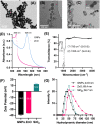Electric field responsive nanotransducers for glioblastoma
- PMID: 36258238
- PMCID: PMC9580136
- DOI: 10.1186/s42234-022-00099-7
Electric field responsive nanotransducers for glioblastoma
Abstract
Background: Electric field therapies such as Tumor Treating Fields (TTFields) have emerged as a bioelectronic treatment for isocitrate dehydrogenase wild-type and IDH mutant grade 4 astrocytoma Glioblastoma (GBM). TTFields rely on alternating current (AC) electric fields (EF) leading to the disruption of dipole alignment and induced dielectrophoresis (DEP) during cytokinesis. Although TTFields have a favourable side effect profile, particularly compared to cytotoxic chemotherapy, survival benefits remain limited (~ 4.9 months) after an extensive treatment regime (20 hours/day for 18 months). The cost of the technology also limits its clinical adoption worldwide. Therefore, the discovery of new technology that can enhance both the therapeutic efficiency and efficacy of these TTFields will be of great benefit to cancer treatment and decrease healthcare costs worldwide.
Methods: In this work, we report the role of electrically conductive gold (GNPs), dielectric silica oxide (SiO2), and semiconductor zinc oxide (ZnO) nanoparticles (NPs) as transducers for enhancing EF mediated anticancer effects on patient derived GBM cells. Physicochemical properties of these NPs were analyzed using spectroscopic, electron microscopy, and light-scattering techniques.
Results: In vitro TTFields studies indicated an enhanced reduction in the metabolic activity of patient-derived Glioma INvasive marginal (GIN 28) and Glioma contrast enhanced core (GCE 28) GBM As per our journal style, article titles should not include capitalised letters unless these are proper nouns/acronyms. We have therefore used the article title "Electric field responsive nanotransducers for glioblastoma" as opposed to "Electric Field Responsive Nanotransducers for Glioblastoma" as given in the submission system. Please check if this is correct.cells in groups treated with NPs vs. control groups, irrespective of NPs dielectric properties. Our results indicate the inorganic NPs used in this work enhance the intracellular EF effects that could be due to the virtue of bipolar dielectrophoretic and electrophoretic effects.
Conclusions: This work presents preliminary evidence which could help to improve future EF applications for bioelectronic medicine. Furthermore, the merits of spherical morphology, excellent colloidal stability, and low toxicity, make these NPs ideal for future studies for elucidating the detailed mechanism and efficacy upon their delivery in GBM preclinical models.
Keywords: Electric fields; Glioblastoma; Inorganic nanoparticles; Tumor Treating Fields.
© 2022. The Author(s).
Conflict of interest statement
The authors declare no conflict of interest. The funders and Novocure had no role in the design of the study; in the collection, analyses, or interpretation of data; in the writing of the manuscript or in the decision to publish the results.
Figures



References
-
- Ahmad MP, Rao AV, Babu KS, Rao GN. Mater Chem Phys. 2019;224:79–84. doi: 10.1016/j.matchemphys.2018.12.002. - DOI
Grants and funding
LinkOut - more resources
Full Text Sources
Other Literature Sources
Research Materials
